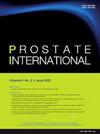体外冲击波疗法对慢性前列腺炎/慢性盆腔疼痛综合征的安全性和有效性:前瞻性、随机、双盲、安慰剂对照研究
IF 2.6
2区 医学
Q2 UROLOGY & NEPHROLOGY
引用次数: 0
摘要
目的:本研究旨在探讨体外冲击波治疗(ESWT)对慢性前列腺炎/慢性盆腔疼痛综合征(CP/CPPS)患者8周的疗效和安全性。材料和方法这项前瞻性、双盲、安慰剂对照研究招募了46名被诊断为CP/CPPS的参与者,他们以2:1的比例随机分配到治疗组和对照组。治疗组于会阴处给予ESWT,每周一次,连续8周。使用美国国立卫生研究院慢性前列腺炎症状指数(NIH-CPSI)评估CP/ cpps相关症状。疼痛和勃起功能采用视觉模拟量表(VAS)和国际勃起功能指数(IIEF-EF)进行测量。结果8周治疗结束后第4周NIH-CPSI总分与基线比较,治疗组(- 11.27±8.39)较对照组(- 5.44±5.73)显著改善(P = 0.0225)。在次要疗效评估变量方面,治疗组在治疗8周结束时的NIH-CPSI总分与基线相比显著降低(P = 0.0055),疼痛和生活质量评分以及治疗8周结束时和治疗结束后4周的VAS评分均显著降低(P <;0.05)。此外,在评估性功能改善的评估中,治疗组在治疗结束后4周的IIEF总分较对照组有显著性升高(P = 0.0364)。在治疗期间或随访期间,没有患者出现与ESWT相关的严重副作用。结论体外冲击波治疗对CP/CPPS有明显的症状改善作用。本文章由计算机程序翻译,如有差异,请以英文原文为准。
Safety and efficacy of extracorporeal shockwave therapy on chronic prostatitis/chronic pelvic pain syndrome: a prospective, randomized, double-blind, placebo-controlled study
Purpose
This study aimed to investigate the efficacy and safety of extracorporeal shock wave therapy (ESWT) over an 8-week period in individuals diagnosed with chronic prostatitis/chronic pelvic pain syndrome (CP/CPPS) compared to a control group.
Materials and methods
This prospective, double-blind, placebo-controlled study enrolled 46 participants diagnosed with CP/CPPS, who were randomly assigned to either the treatment group or the control group in a 2:1 ratio. In the treatment group, ESWT was administered at the perineum once a week for 8 weeks. CP/CPPS-related symptoms were assessed using the National Institutes of Health-Chronic Prostatitis Symptom Index (NIH–CPSI). Pain and erectile function were measured using the Visual Analogue Scale (VAS) and the International Index of Erectile Function-Erectile Function (IIEF-EF).
Results
The primary efficacy assessment variable, the change in NIH–CPSI total score at 4 weeks after the end of the 8-week treatment compared to baseline, was significantly improved (P = 0.0225) in the treatment group (−11.27 ± 8.39) compared to the control group (−5.44 ± 5.73). Regarding the secondary efficacy assessment variables, the treatment group showed significant decreases compared to the control group in change in NIH–CPSI total score (P = 0.0055) at the end of the 8-week treatment compared to baseline, along with significant decreases in pain and quality of life scores, as well as VAS assessments at the end of the 8-week treatment and 4 weeks after the end of treatment (P < 0.05). Moreover, in the evaluation conducted to assess improvement in sexual function, the treatment group showed a significant increase compared to baseline than the control group in the IIEF total score at 4 weeks after the end of the treatment (P = 0.0364). No patients experienced severe side effects related to ESWT during the therapeutic period or the follow-up duration.
Conclusions
The efficacy assessment in this clinical trial indicates that extracorporeal shock wave therapy is expected to have a symptomic improvement effect on CP/CPPS.
求助全文
通过发布文献求助,成功后即可免费获取论文全文。
去求助
来源期刊

Prostate International
Medicine-Urology
CiteScore
4.40
自引率
26.70%
发文量
40
审稿时长
35 days
期刊介绍:
Prostate International (Prostate Int, PI), the official English-language journal of Asian Pacific Prostate Society (APPS), is an international peer-reviewed academic journal dedicated to basic and clinical studies on prostate cancer, benign prostatic hyperplasia, prostatitis, and ...
 求助内容:
求助内容: 应助结果提醒方式:
应助结果提醒方式:


